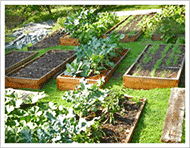Raised beds offer a multitude of advantages. In areas where the soils are heavy and drain poorly, raised beds allow for plant roots to develop in soil that improves root penetration and growth. Drainage and water retention is improved as well. The soil warms earlier in the spring, thus allowing for earlier plantings. The improved soils can lead to higher yields of vegetables and more plants can be grown in a smaller area than with conventional in ground plantings. Maintenance of the beds is easier because the higher beds allow for easier for weeding, watering and other necessary activities.
In constructing raised beds, first choose an area that receives full sunlight and is near a water source. Mark the outer bed dimensions with twine and stakes or use turfgrass paint. Typically a rectangular shape is the most desired and easiest to work. Four feet by six or eight feet is the most popular size. If you are building more than one bed, make sure enough space is available for walkways between them. Remove any vegetation in the area where the bed will be by digging it out or applying a non-selective herbicide such as RoundUp to get rid of the unwanted vegetation.
The beds can be as long as desired, but should only be as wide as can be worked from either side, which is usually four feet. Avoid using railroad ties that contain creosote. This chemical can leach out into the soil causing harm to plants. Use pressure treated lumber, which does not cause any harm to the plants. If you choose to use lumber that is not pressure treated, remember that the lumber will start rotting and it will have to be replaced more frequently. Other materials can be utilized such as cinder blocks, bricks and rocks. Raised beds are normally 6 to 12 inches high, but they can be made higher to reduce bending over and to make them more accessible for people in wheelchairs.
Once constructed, the beds will need to be filled with soil. Work the soil deeply on the site where the raised bed will be located. Add several inches of organic material, such as compost, peat moss, top soil or composted manure, and work it into the existing soil to raise the soil level. The layers should be thoroughly mixed because if the soil has separate, distinct layers, this will inhibit the penetration of water and limit root growth. The soil should be as high as two inches below the top of the bed. Since the beds are above the soil grade, they dry out faster and require constant monitoring for water needs. Apply mulch composed of pine straw, pine bark, cypress mulch, or other similar material one to three inches thick to reduce moisture loss from the soil. Soaker hoses or drip irrigation can help improve the effectiveness of the application of water.
Planting is done much like traditional gardens. Seeds can be planted in rows or clusters. Using transplants is advantageous since the plants already have germinated and are easy to plant and establish. Smaller growing plants are better suited to raised beds; however, larger plants, such as tomatoes and squash can be grown is they are given adequate space and support. Flowers can also be mixed with the vegetables.
If you have a site that is not conducive to the growing of traditional gardens, consider using raised beds. They have numerous benefits, are easy to construct, and will yield abundantly if properly maintained.
Timothy Daly, is an Agricultural and Natural Resource Extension Agent with Gwinnett County. He can be contacted at 678-377-4010 or tdaly@uga.edu


